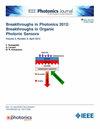基于针孔成像的手腕信息检测传感器
IF 2.1
4区 工程技术
Q3 ENGINEERING, ELECTRICAL & ELECTRONIC
引用次数: 0
摘要
为了满足腕戴式可穿戴设备在人机交互和测量人体生理参数(尤其是动态生理参数)方面的要求,各种传感器的协同工作对于提供足够的感知信息至关重要。本研究介绍了一种基于针孔成像的腕部信息检测传感器(WIDSP)。该传感器利用针孔成像原理,通过图像传感器捕捉手腕处的运动和生理信号。通过对图像数据的处理和分析,它可以实现手部动作的识别和人体生理参数的测量。在评估实验中,WIDSP 的位移补偿功能将鼠标类动作的识别率从 94.67% 提高到 97.33%。此外,该传感器还实现了误差小于 2% 的心率测量,证明了 WIDSP 在腕部信息感知领域的广阔应用前景。本文章由计算机程序翻译,如有差异,请以英文原文为准。
Wrist Information Detection Sensor Based on Pinhole Imaging
For the purpose of meeting the requirements of wrist-worn wearable devices for human-computer interaction and for measuring human physiological parameters, especially dynamic physiological parameters, the collaborative work of various sensors is essential to provide sufficient perceptual information. This study introduces a Wrist Information Detection Sensor Based on Pinhole Imaging (WIDSP). This sensor utilizes the principle of pinhole imaging, employing an image sensor to capture motion and physiological signals at the wrist. Through the processing and analysis of image data, it can achieve the recognition of hand movements and the measurement of human physiological parameters. In the evaluation experiments, the displacement compensation function of WIDSP enhanced the recognition rate of mouse-like movements from 94.67% to 97.33%. Additionally, this sensor achieved a heart rate measurement with less than 2% error, demonstrating WIDSP's broad prospects in wrist information perception applications.
求助全文
通过发布文献求助,成功后即可免费获取论文全文。
去求助
来源期刊

IEEE Photonics Journal
ENGINEERING, ELECTRICAL & ELECTRONIC-OPTICS
CiteScore
4.50
自引率
8.30%
发文量
489
审稿时长
1.4 months
期刊介绍:
Breakthroughs in the generation of light and in its control and utilization have given rise to the field of Photonics, a rapidly expanding area of science and technology with major technological and economic impact. Photonics integrates quantum electronics and optics to accelerate progress in the generation of novel photon sources and in their utilization in emerging applications at the micro and nano scales spanning from the far-infrared/THz to the x-ray region of the electromagnetic spectrum. IEEE Photonics Journal is an online-only journal dedicated to the rapid disclosure of top-quality peer-reviewed research at the forefront of all areas of photonics. Contributions addressing issues ranging from fundamental understanding to emerging technologies and applications are within the scope of the Journal. The Journal includes topics in: Photon sources from far infrared to X-rays, Photonics materials and engineered photonic structures, Integrated optics and optoelectronic, Ultrafast, attosecond, high field and short wavelength photonics, Biophotonics, including DNA photonics, Nanophotonics, Magnetophotonics, Fundamentals of light propagation and interaction; nonlinear effects, Optical data storage, Fiber optics and optical communications devices, systems, and technologies, Micro Opto Electro Mechanical Systems (MOEMS), Microwave photonics, Optical Sensors.
 求助内容:
求助内容: 应助结果提醒方式:
应助结果提醒方式:


